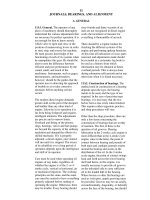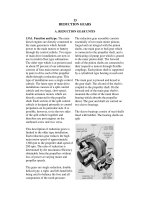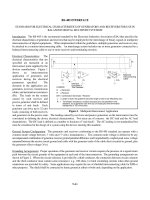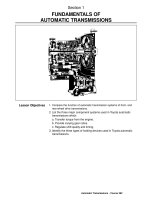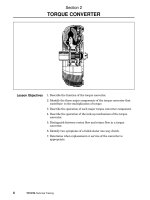Tài liệu Automatic Transmissions P11 pptx
Bạn đang xem bản rút gọn của tài liệu. Xem và tải ngay bản đầy đủ của tài liệu tại đây (169.59 KB, 19 trang )
Automatic Transmissions - Course 262 163
1. -Perform pressure test of the automatic transmission using
appropriate pressure gauge set.
2. Perform stall test of automatic transmission vehicle using procedure
described in appropriate repair manual.
3. Using an ECT Analyzer, distinguish between mechanical and electrical
failures in electronic control transmissions.
4. Using a voltmeter at the diagnostic connector, determine if the ECT
ECU is processing input and directing output signals correctly.
5. Using a voltmeter at the diagnostic connector, determine if the throttle
position switch and brake switch inputs to the ECT computer are
correct.
Section 11
TRANSMISSION CHECK,
ADJUSTMENTS AND DIAGNOSIS
Lesson Objectives:
Section 11
164 TOYOTA Technical Training
The transmission requires regular maintenance intervals if it is to
continue to operate without failure. As we discussed in previous
sections, transmission fluid loses certain properties over time and
especially due to heat.
The Maintenance Schedules found in the repair manual or the Owners
Manual indicate the appropriate replacement schedules based on how
the vehicle is used. Schedule A for example, recommends replacement
of the fluid every 20,000 miles or 24 months. Whereas Schedule B
recommends just an inspection of the fluid every 15,000 miles or 24
months and no replacement interval.
The chart below indicates which maintenance schedule to follow based
on the use of the vehicle.
Maintenance
Schedule Selection
Checks and
Adjustments
TRANSMISSION CHECKS, ADJUSTMENTS AND DIAGNOSIS
Automatic Transmissions - Course 262 165
The fluid level in the automatic transmission should be inspected by
means of the dipstick after the transmission has been warmed up to
ordinary operating temperature, approximately 158°F to 176°F. As a
rule of thumb, if the graduated end is too hot to hold, the fluid is at
operating temperature. The fluid level is proper if it is in the hot range
between hot maximum and hot minimum.
The cool level found on the dip stick should be used as a reference only
when the transmission is cold. The correct fluid level can only be found
when the fluid is hot.
Fluid Level Check
It is important to keep the fluid at the correct level at all times to
ensure proper operation of the automatic transmission. If the fluid
level is too low, the oil pump will draw in air, causing air to mix with
the fluid. Aerated fluid lowers the hydraulic pressure in the hydraulic
control system, causing slippage and resulting in damage to clutches
and bands. If the fluid level is excessive, planetary gears and other
rotating components agitate the fluid, aerating it and causing similar
symptoms as too little fluid. In addition, aerated fluid will rise in the
case and may leak from the breather plug at the top of the
transmission or through the dipstick tube.
In addition, be sure to check the differential fluid level in a transaxle.
This fluid is sealed off and separate from the transmission cavity in
some applications.
Fluid Level
NOTE
Section 11
166 TOYOTA Technical Training
The throttle cable is adjustable on all automatic transmissions. And in
each case it controls throttle pressure. Throttle pressure is an
indication of load. When the throttle is depressed, the cable transfers
this motion to the base of the throttle valve and moves it upward to
increase throttle pressure. Throttle pressure causes the primary
regulator valve to increase line pressure. As the throttle is depressed,
greater torque is produced by the engine and the transmission may
also downshift to a lower gear. If line pressure did not increase,
slippage could occur which would result in wear of the clutch plate
surface material.
Throttle pressure’s affect on transmission operation differs between a
hydraulically controlled transmission (non−ECT) and an electronically
controlled transmission (ECT). In a non−ECT transmission, throttle
pressure affects shift points and line pressure; whereas in an ECT
transmission it only affects line pressure. Control of line pressure will
affect the quality of the shift, not the shift points, in an ECT
transmission.
Throttle Cable
Adjustment
Throttle Cable
TRANSMISSION CHECKS, ADJUSTMENTS AND DIAGNOSIS
Automatic Transmissions - Course 262 167
To inspect the throttle cable adjustment, the engine should be off.
Depress the accelerator pedal completely, and make sure that the
throttle valve is at the maximum open position. If the throttle valve is
not fully open, adjust as needed.
With the throttle fully open, check the throttle cable stopper at the boot
end and ensure that there is no more than one millimeter between the
end of the stopper and the end of the boot. If adjustment is required,
make the adjustment with the throttle depressed. Loosen the locking
nuts on the cable housing and reposition the cable housing and boot as
needed until the specification is reached.
The Land Cruiser A440 automatic transmission throttle cable is
adjusted differently, as seen below. It is measured in two positions. The
first measurement is made with the throttle fully closed. The distance
varies in that the measurement is made from the end of the boot to the
front of the stopper. Measure the same distance with the throttle in the
fully open position.
Throttle Cable
Adjustment
The illustration below represents yet another adjustment type. The
rubber boot has a shallow extension when compared to the first one
discussed earlier. The procedure differs in that the throttle is left in the
fully closed position when the distance is measured from the front of
the boot to the front of the stopper.
Throttle Cable
Adjustment
Inspect and Adjust
the Throttle Cable
Section 11
168 TOYOTA Technical Training
To inspect the shift cable, move the gear selector from neutral to each
position. The gear selector should move smoothly and accurately to
each gear position. Adjust the shift cable if the indicator does not
line−up with the position indicator while in the proper detent. To
adjust, loosen the swivel nut on the shift linkage. Push the manual
lever at the transmission fully toward the torque converter end of the
transmission. Then pull the lever back two notches from Park through
Reverse to the Neutral position. Set the selector lever to the Neutral
position and tighten the swivel nut while holding the lever lightly
toward the reverse position.
Shift Cable
Adjustment
Idle speed is an important aspect for transmission engagement. If set
too high, when shifting from neutral to drive or reverse, the
engagement will be too abrupt, causing not only driver discomfort, but
also affecting the components of the transmission as well. And, of
course, if the idle is too low, it may cause the engine to stall or idle
roughly.
To adjust the idle speed:
• The engine should be at operating temperature.
• All accessories should be off.
• Set the parking brake.
• Place the transmission in park or neutral position.
• Engine cooling fan should be off.
Inspect and Adjust
the Shift Cable
Check Idle Speed
and Adjust if
Applicable
TRANSMISSION CHECKS, ADJUSTMENTS AND DIAGNOSIS
Automatic Transmissions - Course 262 169
During diagnosis, always verify the customer complaint. If the
verification includes a test drive, be sure to check the level of ATF first.
This will ensure that a low level is not contributing to the problem and
give you an idea as to the condition and service that the vehicle has
seen. Although preliminary checks suggest making adjustments, drive
the vehicle before any adjustments in order to experience the same
condition as the customer. If you are unable to verify the problem, ask
the customer to accompany you on the test drive and point−out when
the condition occurs.
When test driving a vehicle, have a plan and record your findings. The
chart that follows is quite thorough and provides room for comments.
Rather than trying to remember the results of a specific test, simply
refer to the diagnostic form. Not only do you want to find out what has
failed, but also what is functioning properly. Armed with this
information, you will save time in your diagnosis and be more
thorough.
Diagnosis




